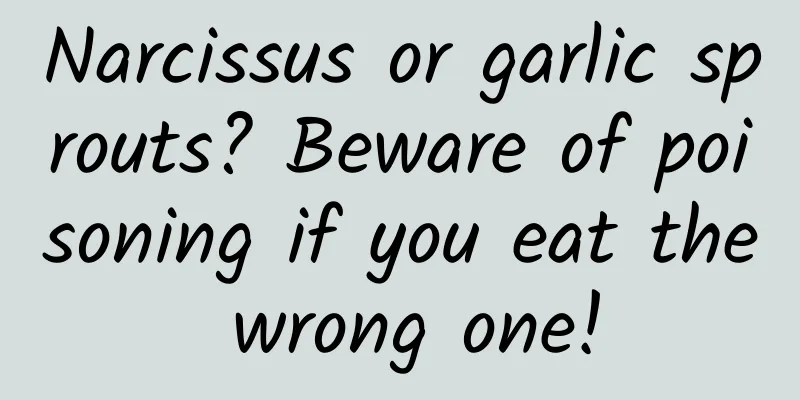Narcissus or garlic sprouts? Beware of poisoning if you eat the wrong one!

|
Audit expert: Li Guangwang Director of the Natural Education Department of Beijing Children's Palace, Senior Teacher Recently, a news story became a hot topic. A couple mistook the leaves of daffodils planted on their windowsill for garlic sprouts and fried them to eat. As a result, they were both poisoned and rushed to the hospital for treatment. Although they found that the taste of the food was a bit unusual during the meal, they did not pay much attention to it. Soon after the meal, they felt stomach discomfort and had symptoms of nausea and vomiting. In fact, there are cases of poisoning from eating daffodils every Spring Festival. This is because unflowered daffodils are similar to garlic sprouts, and people are in the familiar environment of home, so their vigilance is greatly reduced, and they may take daffodils as vegetables. How to distinguish daffodils and garlic sprouts? Narcissus is a perennial herbaceous flower of the Amaryllidaceae family. The toxins mainly come from the juice in the bulb, which contains lycorine, latin, pseudolycorine, lycorine, lycorine and other toxic substances. Eating or applying them externally can cause poisoning symptoms such as gastrointestinal reactions, skin redness and swelling, etc. But if you look closely, you can easily identify daffodils: 1. Leaf thickness and length : Narcissus leaves are usually thicker and flatter, while garlic leaves are relatively thinner and uneven. 2. Rhizome shape : The rhizome of daffodil is conical or oval, more similar to the shape of an onion, and is larger in size; the bulb of garlic is composed of multiple cloves, each of which is independent and smaller in size. 3. Smell : Garlic releases a strong pungent smell when its leaves or bulbs are damaged, but daffodils do not. 4. Flowering period : Narcissus flowers are white or other colors, while garlic does not produce decorative flowers. Source | Sohu When handling daffodils, we also remind everyone to wear gloves, masks, glasses and other protective equipment to prevent contact with the juice. If you accidentally come into contact with the daffodil juice, rinse it off with clean water immediately. If the patient accidentally takes too much daffodils and is poisoned, he must immediately drink warm water to induce vomiting , or take pure milk, egg white, etc. to protect the gastric mucosa, and seek medical attention as soon as possible. In addition, the medical community currently has no special antidote for daffodils, so families with children should be extra careful not to let children touch daffodils. Considering the impact on patients with allergies, daffodils are not suitable for placement in the bedroom. Not only daffodils, but also these plants should be watched out for! In addition to daffodils, many ornamental plants contain toxins. Take the Weeping Goddess of Mercy as an example. Its scientific name is Alocasia odora, and it was called "Lotus of Goddess of Mercy" and "Shy Grass" in ancient times. When the soil is warm and humid and the soil is well hydrated, it will drip water from the tip or edge of the leaves. Weeping Goddess of Mercy has the effect of clearing dust from the air and is often used as a decoration in the room. However, the white juice in the stem of Weeping Goddess of Mercy is poisonous, and the dripping water is also poisonous . If you touch or eat its juice by mistake, it will cause discomfort in the throat and mouth, sometimes swelling, and in severe cases, suffocation. The skin will also be strongly irritated after contact with its juice, and it is more likely to cause severe conjunctivitis if the eyes come into contact with the juice. Source | Sohu Hyacinthus has always been a favorite flower breeding object for horticultural plant breeders. It not only has rich colors, but also large and beautiful inflorescences. Many people plant hyacinths in pots and water at home. However, although the flowers are beautiful and the meaning is beautiful, its bulbs are toxic . If eaten by mistake, it will cause dizziness, stomach cramps, diarrhea and other symptoms, so it is necessary to prevent children or animals from eating it by mistake. Source | Sohu In addition, plants such as oleander and poinsettia also contain certain toxins. It is also recommended that when purchasing plants, you must understand whether they are toxic and treat them with caution to avoid contact with children and pets. Before eating any wild or unfamiliar plants, you must also confirm their safety. For plants that already exist in your home, especially those that may be toxic, make sure they are placed in a safe place to avoid accidental ingestion. If you accidentally ingest a toxic plant, you should stop eating it immediately and seek medical attention in time according to the severity of the poisoning symptoms. |
<<: A mathematical genius who cracked the German code during World War II took the secret with him
>>: What chemical materials are used in the epoch-making brain-computer interface?
Recommend
The latest progress of Android Studio 4.0, these new features are really awesome
[[281021]] Latest progress, these new features are...
Satellite reveals! This is how the United States treats minors who enter the country illegally!
Every day, hundreds of remote sensing satellites ...
Not everyone can have laser surgery for myopia!
Reviewer of this article: Xu Qibin, associate chi...
Things to note when increasing downloads of startup apps in the Apple Store!
1. Make sure users can find your app! If users kn...
Comrades, please wait a little longer. The salary increase will be the highest in March and April.
[[161294]] This article mainly talks about indust...
Why should we pay attention to rare diseases? The significance is more than just "curing diseases and saving lives"!
Today is the 17th International Rare Disease Day....
Explore NVIDIA's leadership in China's high-end ADAS sector
Recently, NVIDIA was ranked the champion of Canal...
Jiebao linkage system course "Leopard Brother Short-term Practical System Course" and "Jiebao Trading System Advanced Edition" video tutorial
Course Contents: 1. [Xiaojie Night News] Jiege Tr...
Dalian cancels China International Beer Festival (full text)
The organizing committee of the 21st China Intern...
「User acquisition」The core of new product user growth
When it comes to growth, the first thing that com...
Functional Animation in UX Design
[[149375]] A good UX designer can easily explain ...
6 high-quality details of 100,000+ soft article titles
For soft articles, the first impression is the ti...
Growth has reached a bottleneck? Why is the maximum storage capacity of mobile phones limited to 256GB?
The storage capacity of smartphones is getting big...
Don't be a leader who is overwhelmed, a private lesson on management with an annual salary of one million
[Private management lesson for those with an annu...









